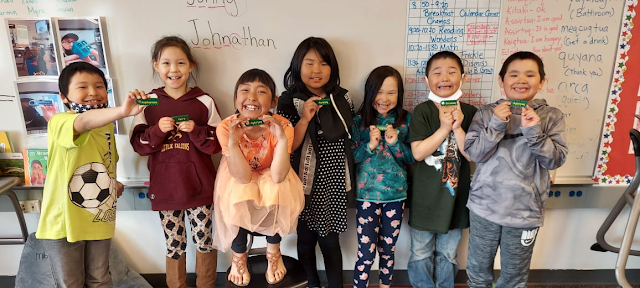Indigenous Youth of Alaska and 3D Printing Technology
by Susan Waruingi
"Nothing is impossible with a little ingenuity," says Nelressa Faye, a Kotlik school educator, new to Alaska, US. Faye shares a game changing experience to the students of Kotlik after they interacted with 3D printing technology for the first time with Facilities Manager, Kim Riggs from the University of Alaska.
Happy and motivated pupils after a 3D Printing lesson
It is with the acknowledgement of such challenges that the UArctic Thematic Network Arctic Indigenous Skills exists to support indigenous traditions and culture. The network is empowering the identity, self-respect and awareness of Arctic indigenous communities by bringing together the youth, their teachers, experts of education; enabling them to share their knowledge, experiences and best practices over a variety of themes, languages and education.
Through the network, Faye created a positive learning environment for her indigenous students to keep them engaged and receptive to technology. Together with her second grade class they collaborated with Kim Riggs from the University of Alaska-Anchorage, Engineering Department to learn about 3D printing.
3D printing is a process of making three dimensional solid objects from a digital file. It enables one to produce complex shapes using less material than traditional manufacturing methods which involves cutting pieces out from metal or plastic.
An example of a 3D model keychain
This activity facilitated a radical change in the mindset of the Yupik pupils because it helped them think about attending college in the future to study engineering, machine learning and entrepreneurship. Therefore, it is important for the indigenous communities to have access to new technology and resources so they are not at a disadvantage. To teach effectively, educators must simulate their environment to help learners’ understanding and visualize learning outcomes for the future.
Faye says that learning about 3D printing machines can assist villages in building their own materials instead of ordering online and waiting for parts to be shipped into the villages. This can lead to creating services in a timely manner and even provide jobs for machinists. There are other benefits associated with 3D printing such as risk reduction, accessibility, consistency, quality of design and competency. For example, through proper illustrations, manufacturers can effectively test markets and gain feedback from prospects without necessarily investing risky amounts of money in prototyping. Another competitive advantage of 3D printing is that it has led to many advancements in the medical field. During the COVID-19 pandemic the University of Alaska created ventilation masks for local hospitals supplying resources that would have otherwise taken a long time to manufacture and ship. Furthermore, 3D printing is a sustainable method for industrial manufacturing since materials used can be recycled thus making it cost effective and flexible to use.
Availing the resources and modeling education curriculum in a way that promotes 3D printing is one of the ways of developing employability skills of the indigenous students in Alaska. Thanks to UArctic Thematic Network Arctic Indigenous Skills, Faye and her second grade class are able to explore resources that would have normally been unavailable to indigenous students, taking them to the forefront of the technology frontier.
References:
Ayunerak, P., Alstrom, D., Moses, C., Charlie, J., Sr, & Rasmus, S. M. (2014). Yup'ik culture and context in Southwest Alaska: community member perspectives of tradition, social change, and prevention. American journal of community psychology, 54(1-2), 91–99. https://doi.org/10.1007/s10464-014-9652-4
Yupik People of Alaska: Culture, Food & Traditions. (2017, July 31). Retrieved from https://study.com/academy/lesson/yupik-people-of-alaska-culture-food-traditions.html.
Yupik Peoples: History, Language & Tools. (2017, August 1). Retrieved from https://study.com/academy/lesson/yupik-peoples-history-language-tools.html.
https://www.uarctic.org/organization/thematic-networks/arctic-indigenous-skills/
https://www.tinkercad.com/
https://3dprinting.com/


Comments
Software Testing Training Institute in Delhi- Technologies Goes On And On
Know The Information about AutoCAD Training & Placement
IS java Training Course Good For Your Future
apart from this if someone is looking for the best institute for
python training institute in delhi
i will recommend High Technologies Solutions,
Python Certificate Course by High Technologies Solutions . Get Hands-On Training on Python in Just 4 Weeks.
Learn Python language in Delhi by Industry Expert with 100% Placement Assistance. All IT technologies. LAB Facilities. E learning portal. Courses: Free Demo, Live Project.
contact us on 9311002620
visit website for more details -https://www.htsindia.com/Courses/python/python-training-institute-in-south-delhi
Read more here
Emotional Management and Developing Emotional Skills
Social and Emotional Development Lesson Plan
The best fitness mat best options for your workout
Best social activity and skills for young people
How to help a child with learning disability
A forest of yoga mats for every human
As these examples clearly show
Study Abroad and Immigration Consultant
follow us